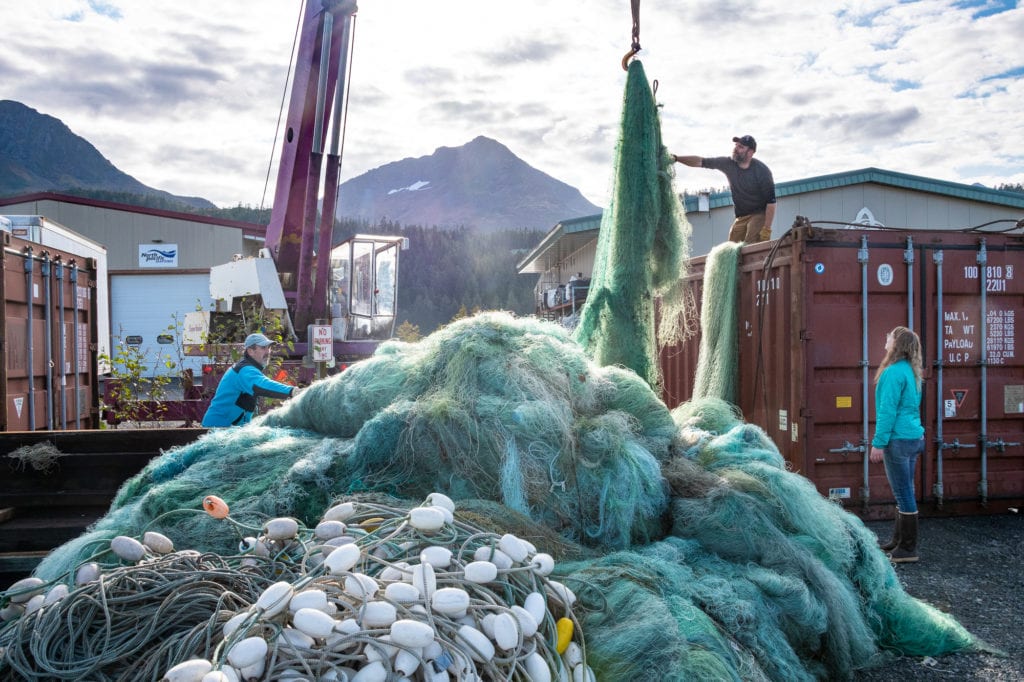
Over one million pounds of old fishing nets and lines from Alaska have made it to recycling markets so far, where they are remade into plastic pellets and fibers.
The milestone was reached with a recent haul of nets from Dutch Harbor and more are already adding to the total. Shipping vans filled with old gear collected at Haines were offloaded in Seattle in mid-November and another container from Cordova was on its way.
Dutch Harbor was the first to sign on four years ago with Net Your Problem (NYP), a small Seattle-based company that jumpstarted fishing gear recycling in Alaska and facilitates its collection and transport, primarily to Europe. The NYP team has partnered with the city and the region’s Qawalangin tribe to sort through piles of old nets and lines dumped at the landfill and do continuing outreach to boat owners to encourage them to recycle their gear.
Similar partnerships have formed in other Alaska coastal communities to start and/or sustain a recycling effort.
At Cordova, the Copper River Watershed Project collected and prepped roughly 16,000 pounds of gillnets for recycling so far, said NYP founder Nicole Baker-Loke, a former Alaska fisheries observer and current research associate at Washington State University.
“Cordova is a jewel and we’ve been working with them for two years,” she said, adding that Grundens, maker of outer wear and foul-weather gear for mariners, is using regenerated nylon fabric from Cordova’s recycled fishing nets in several of its clothing lines.
The Haines Friends of Recycling group also has been collecting nets and lines for two years and has so far gone through the arduous task of making sure roughly 8,000 pounds were compliant for recycling.
Fishing gears are made with a myriad mix of plastics and other materials that must be stripped off to be accepted by recyclers, Baker-Loke explained. It’s especially problematic with trawl nets that are collected for recycling at Kodiak.
“One of the things that has really changed for us this year is new regulations restricting the export of mixed plastic waste. It is now very difficult to send multiple types of plastic in a same container to a different country. The polyethylene, polyester, nylon, we need to separate them into their different components before we can ship them out for recycling,” she said. “We have recently signed a new lease for a bigger warehouse in Seattle that will allow us to process the nets there before we send them out.”
Homer is in NYP’s lineup for fishing gear recycling, Baker-Loke said, and Naknek will begin a program next summer. Her small team also hopes to restart gear recycling in Dillinghamand has connected with the Alaska Tribal Conference on Environmental Management to make more coastal regions aware of the opportunity.
NYP was recently accepted as a vendor in the Backhaul Alaska program, a statewide logistical support system that removes hazardous wastes, old electronics and other items from remote communities.
“If you are one of the participating communities and there is space in the containers that are being sent out through the backhaul program, you only need to pay the recycling fee once it gets to Seattle. You don’t need to pay for any of the transportation, because that is covered by the backhaul program,” Baker-Loke explained, crediting Sen. Lisa Murkowski for the statewide effort. “That’s another option for communities that may not be participating with NYP yet but are already plugged into this backhaul network.”
Net Your Problem also has launched recycling programs on the east and west coasts with a goal of offering the option to all of the major fishing ports in the U.S.
“I think we’re on our way there,” Baker-Loke said, “and we will work with any interested communities.”
Bay booms again
Another massive sockeye run topping 75 million fish is expected at Bristol Bay next summer, 44% larger than the 10-year average, and well above the record of more than 66 million fish that returned this year.
State managers project a 2022 catch of just under 60 million sockeyes from Bristol Bay’s nine river systems and nearly 2 million at the South Peninsula.
Conversely, at Southeast Alaska a catch of 16 million pink salmon is projected for 2022, down from 48 million pinks this summer.
Several regional salmon summaries for 2021 are posted at Fish and Game’s commercial fisheries page. Some highlights:
Bristol Bay’s catch of 40.8 million salmon of all species and the preliminary value of $248 million both rank fourth over the last 20 years.
At Prince William Sound, a harvest of nearly 70 million fish had a value topping $121 million to fishermen, 14% higher than the 10-year average. Average earnings for 477 drift gillnetters were $52,700, compared to a 10-year average of $79,100.
At Kodiak, 300 permit holders fished this year (51%) for a salmon catch that topped 30 million, well above the 10-year average. The estimated value topped $47 million, with Kodiak seiners each averaging $250,550.
The 2021 Upper Cook Inlet catch of 1.7 million salmon was the third smallest since 1975. The value to fishermen of about $14 million was the second lowest in 10 years and 48% below the 10-year average.
Poor runs of chum and coho salmon to Norton Sound resulted in the worst catches since the record lows of the early 2000s. The pink run was well below the records of the last 5 years but produced the fifth highest harvest in 61-years due to two buyers on the grounds for the first time in 20 years. The combined harvest of nearly 304,000 salmon was valued at nearly $445,000 to 131 fishermen, less than a quarter of the value over five years but more than 53% higher than last year due to the market for pinks.





